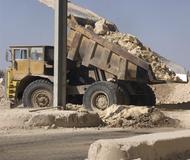Manufacturing process
From quarrying to the delivery of the end product, follow every step of the cement manufacturing process.
Step 1: Extraction of Raw Materials |
|
|
The raw materials needed to produce cement (calcium carbonate, silica, alumina and iron ore) are generally extracted from limestone rock, chalk, clayey schist or clay. Suitable reserves can be found in most countries. These raw materials are extracted from the quarry by blasting. They are then crushed and transported to the plant where they are stored and homogenized. |

Raw materials that produces cement:
Iron Oxide (Fe2O3): Iron Oxide is sourced from iron ore, iron scale and Pozzolana |
Step 2: Raw Grinding and Burning |
|
|
Once the homogenization process is complete, the raw mix - or "kiln feed" - is fed into a preheating tower where it is heated and starts to react chemically by counter flow process; as raw meal moves downwards by gravity, and hot gases resulting from the fuel combustion in the rotary kiln move upwards. Kiln feed is heated from approximately 80°C up to 850°C, causing a series of chemical reactions that include moisture evaporating, limestone calcination and primary bonds between raw materials are created. During this process, the emitted gases - which include CO2 as a result of the calcinations process - are cooled down from 1,050°C to 350°C, to be used afterwards to dry out the wet raw materials during the grinding process. Calcined raw materials are fed to the rotary kiln where they are burnt at 1,450°C to produce the main cement constituent named "Clinker". |

Rortary KilnThe rotary kiln is a large rotating cylinder of 70 m in length and 4 m in diameter, and is where fuel combustion takes place through a burner-pipe located at the discharge end of the kiln. The slightly-inclined cylinder rotates about its axis to induce materials sliding all the way through it towards the discharge end. CO2 and cement Why does the manufacture of cement produce CO2?
|
Step 3: Cement Grinding and Shipping |
|
|
Following the cooling stage, gypsum is added to the clinker and the mix is then finely ground to a form of grey powder called "cement" in a finishing mill, which is similar to a raw material mill but relatively larger in size.
The ground cement is then mechanically packaged in 50kg paper bags and loaded onto trucks to be transported to the marketplace. |

|





